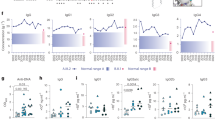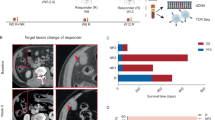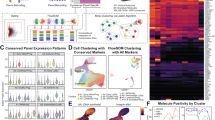Abstract
The extensive breakdown of immune homeostasis in the motheaten mouse (me/me) has been ascribed to a single gene defect on chromosome 6 (ref. 1). These mice develop skin lesions within the first week of life, do not thrive, and die within the first 3–8 weeks2. There is severe hypergamma-globulinaemia3 with multiple species of circulating autoanti-body3–5 and deposition of immune complexes in the thymus, skin, lungs and kidneys1,3. A single gene defect producing such catastrophic results may provide an important model for understanding autoimmune phenomena. We report here a virtual absence of terminal deoxynucleotidyl transferase-positive (TdT+) cells in the bone marrow, thymus and spleen of motheaten mice. TdT is a DNA polymerase which has the unique capacity to polymerize nucleotides in the absence of template direction6. Although no in vivo biological function of this enzyme has been established, its unique appearance in the bone marrow and thymus of adult mammals and its in vitro biochemical activity6 have led to a proposed role for TdT in the somatic diversification of lymphocytes7. Bone marrow TdT+ cells have been shown to belong to both T8 and B9,10 cell populations and may also include precursor cells common to these lineages11. Although the role of TdT in the acquisition of appropriate T- and B-cell specificities is not known, our results are the first to correlate the virtual absence of TdT+ cells with a severe autoimmune syndrome. We investigated the level of TdT+ cells in neonatal me/me mice and their normal littermates and the susceptibility of TdT+ cells to circulating autoantibody in motheaten mouse serum.
This is a preview of subscription content, access via your institution
Access options
Subscribe to this journal
Receive 51 print issues and online access
$199.00 per year
only $3.90 per issue
Buy this article
- Purchase on SpringerLink
- Instant access to full article PDF
Prices may be subject to local taxes which are calculated during checkout
Similar content being viewed by others
References
Green, M. C. & Shultz, L. D. J. Hered. 66, 250 (1975).
Kincade, P. W. in Immune Defects of Laboratory Animals (eds Gershwin, M. E. & Merchant, B.) (Plenum, New York, in the press).
Shultz, L. D. & Green, M. C. J. Immun. 116, 936 (1976).
Shultz, L. D. & Zurier, R. B. in Genetic Control of Autoimmune Disease (eds Rose, N. R., Bigazzi, P. E. & Warner, N. L.) 229 (Elsevier, New York, 1978).
Davidson, W. R., Morse, H. C., Sharrow, S. O. & Chused, T. M. J. Immun. 122, 884 (1979).
Bollum, F. J. Blood 54, 1203 (1979).
Baltimore, D. Nature 248, 409 (1974).
Silverstone, A., Cantor, H., Goldstein, G. & Baltimore, D. J. exp. Med. 144, 543 (1976).
Janossy, G. et al. J. Immun. 123, 1525 (1979).
Landreth, K. S., Rosse, C. & Clagett, J. Fedn. Proc. 39, 806 (1980).
Goldschneider, I., Metcalf, D., Mandel, T. & Bollum, F. J. J. exp. Med. 152, 438 (1980).
Goldschneider, I., Gregoire, K. E., Barton, R. W. & Bollum, J. Proc. natn. Acad. Sci. U.S.A. 74, 734 (1977).
Shultz, L. D., Sidman, C. L. & Unanue, E. R. in Animal Models of Comparative and Developmental Aspects of Immunity and Disease (eds Gershwin, M. E. & Cooper, E. L.) 260 (Pergamon, New York, 1979).
Landreth, K. S., Rosse, C. & Clagett, J. (in preparation).
Hutton, J. J. & Bollum, F. J. Nucleic Acids Res. 4, 457 (1977).
Sidman, C. L., Shultz, L. D. & Unanue, E. R. J. Immun. 121, 2392–2399 (1978).
Sasaki, R., Bollum, F.J. & Goldschneider, I. J. Immun (in the press).
Author information
Authors and Affiliations
Rights and permissions
About this article
Cite this article
Landreth, K., McCoy, K., Clagett, J. et al. Deficiency in cells expressing terminal transferase in autoimmune (motheaten) mice. Nature 290, 409–411 (1981). https://doi.org/10.1038/290409a0
Received:
Accepted:
Issue date:
DOI: https://doi.org/10.1038/290409a0



